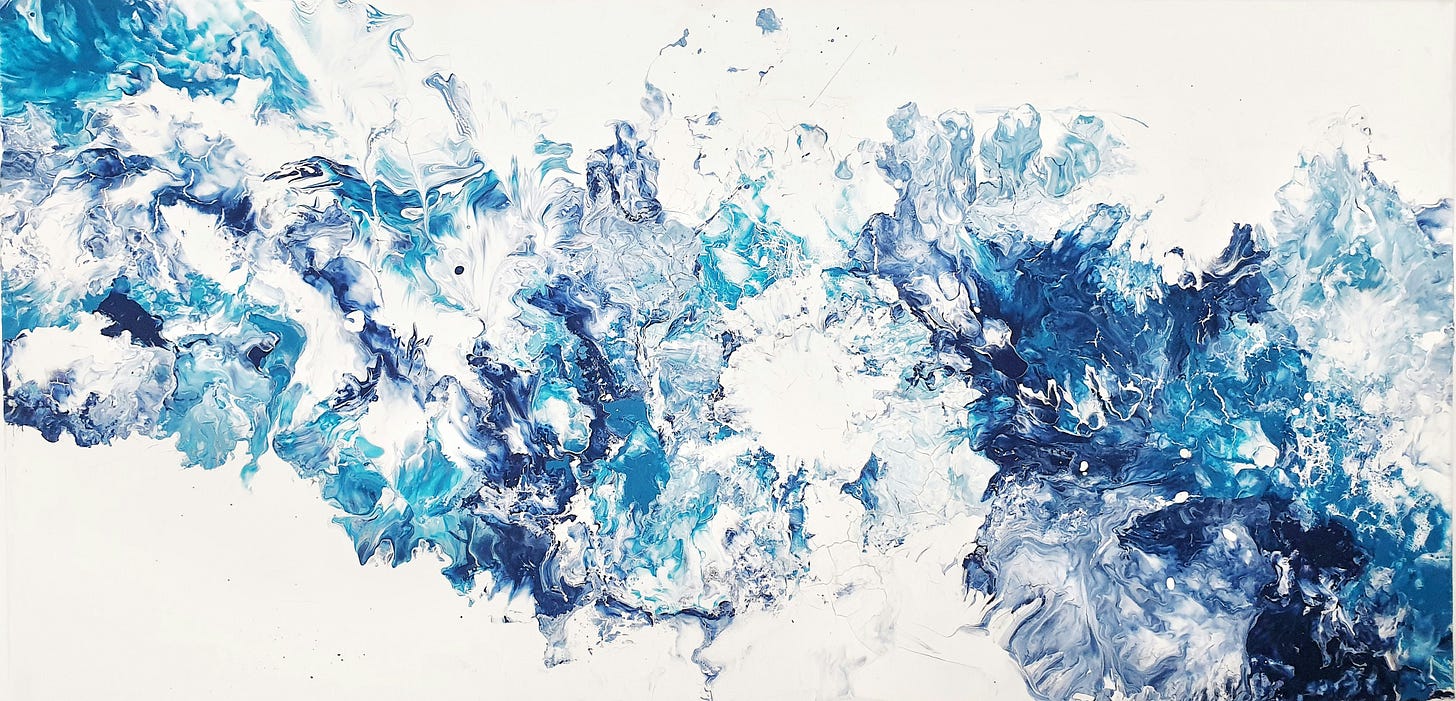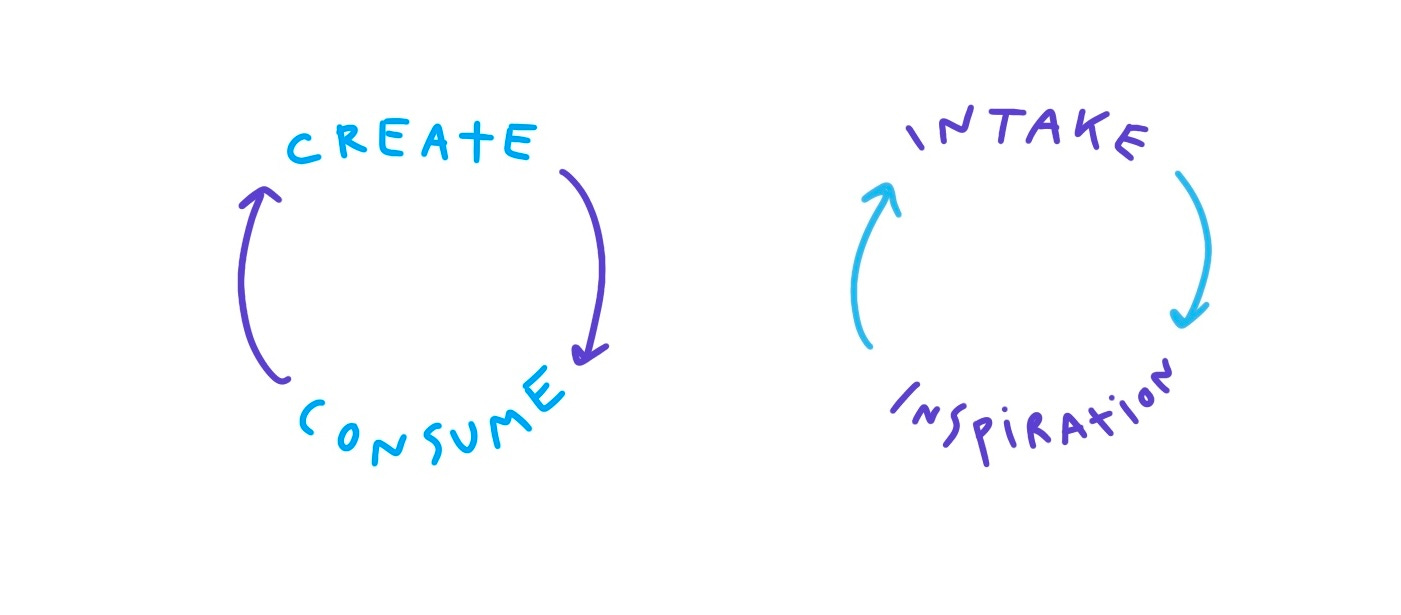Fallow time
Relaxing into creativity

Recently, I finished a big project. I gave myself an easy afternoon off, caught up with friends I’d long neglected, and popped some cava at dinner that night. Celebration? ✅
The next day was mostly filled with life admin I’d been putting off to hit my deadline. But then, while walking my dog, an idea came to me for a new project. It was the seed of an idea—blurred around the edges and half hidden in shadow, but if you looked close enough, yes, there was definitely something there.
Any creative person will tell you beginnings are exciting. Ideas can strike fully formed and fleshed out, or half-baked and in need of coloring in. Inspiration can come from anywhere. In the early days, you have to flirt with the idea—see if it has legs, see if you’re meant to be. Is there a “there” there? Or does it just look and sound good but lack any real substance?
The day this idea struck (and yes, I’m being intentionally vague, I know; you have to protect ideas in their infancy or they might not survive the pressures of reality), it was oozing with potential. Imagine taking a small piece of play dough and rolling it around, adding bits and pieces as you go, maybe a little bit of this color and a little bit of that, the ball growing bigger and bigger with every turn. That’s what it felt like to play with this idea; everything it touched made the idea grow. I could do this or that or what about even this other thing? The sense of possibility was heady and seductive. This, I thought with glee, was it: my next book project.
In my mind’s eye I saw where the story would begin. I had the beginnings of my main character and her supporting cast. I had the perfect opening scene. I had a sense of some of the main beats. I had way more figured out at this early stage than I had with my last novel. (Yes, it’s a novel. Yes, it’s my second. Surprise! More on that soon.)
And so, like a good worker bee, the next day I gathered my thoughts and my notes and all the little emails I’d sent to myself while walking the dog and running errands—all the little bits and pieces of inspiration I expected to amount to something real—and sat down to write.
Yet when I took these loose beginnings and tugged on these perfect threads, the only thing that happened was that I hated every word of it. The main character was irritating and entitled. How had she become so annoying? Her husband sounded like a complete dolt. Her children were fine enough, but there was no spark to them—nothing to make them leap from the page, and did I even need my main character to have kids? The more I wrote, the more certain I became that this story did have legs—it could become something exciting, even great. But this was not it. There was no way I could stick with the project if I didn’t like my own main character. And if I didn’t like her, why would readers?
In a previous life, I might have forced myself to keep going. Butt in seat, pen and paper in hand, noise-cancelling headphones on: Just! Keep! Going! Surely something interesting would eventually emerge. A character would surprise me. I would learn something meaningful about my protagonist. A pivotal lot detail would surface. Like an artist chiseling away at a block of granite, fumbling around until the real shape revealed itself.
All that can happen—it’s happened to me, and many writers, before. There is a wisdom to pushing through and keeping at a project. To persisting. To writing even when you really don’t feel like it.
But with every word I wrote, I could feel the effort. I kept trying to skip the boring bits, to gloss over everything that irritated me about my main character and get to her likable side. It was like trying to fit a square peg in a round hole: Make! It! Fit! Reader, there is nothing worse than reading a story where you feel just how hard the author is working. And I was trying too hard.
So this time, instead of trying to force it, I stepped back. I remembered something I’d learned while researching Rest Easy. Sometimes your brain needs a break. Sometimes the best way to solve a problem is to let go of it.
Taking breaks and stepping back from creative roadblocks gives our brains a chance to solve our problems without all that deep thinking, especially if we trade working for mind-wandering. Mind-wandering is a feature of the default mode network, the part of the brain that is active during rest states. This mode is responsible for our ability to be introspective, empathic, and creative. When we’re not paying attention, other ideas can surface. This explains why we daydream and have our best ideas in the shower. Examples of activities that facilitate mind-wandering include people-watching, driving, doodling, puzzling, or even washing the dishes. No wonder I kept having strokes of insight while walking my dog, en route to pick up my son from school, and even while dreaming in the middle of the night.
On the other hand, overstimulating ourselves and pushing ourselves to do more is more likely to lead to burnout than creative genius.
Knowing this, I decided to embrace a fallow period. A fallow period is a time in which very little happens. The focus is not on production or creation, but on inactivity. The term originates in agriculture; a fallow period means the soil is left undisturbed to allow it to recover its nutrients and moisture and be more fertile for future seasons of growth. In other words, you leave the soil alone as an investment in its future growing capabilities.
I was not ready. I could not rush it. I needed to slow down. And I was going to lean into it.
My fallow period would be a period of reading, listening to audiobooks, taking walks—basically pretending I’m back in grad school, but with very little to no writing. I returned to an old habit of mine from the pre-iPhone era of carrying a small notebook wherever I go to jot down lines of inspiration as they came. I chose a deliberately small notebook—perfect for capturing stray thoughts about characters or plot lines or descriptions, but far too small to write entire scenes or chapters in. Instead of word count goals (usually I aim for 1k a day), I would just try to get through as many books as I could, after which I’d stare at the wall or look up at the ceiling and think through what I’d read and what I liked or disliked about it. (The latter sometimes being the most informative.)
I admit, when my husband is WFH and so am I, I feel a bit silly. It looks like I’m not working, lying there on the couch with a stack of novels by my side, turning page after page and getting up only to make myself more tea or switching to an audiobook while I do laundry or get a jump on making school lunch for the week. His work looks like what my work used to look like, back when I was full time in the tech industry: endless meetings, lots of computer time, and the air of busyness that plagues anyone with a packed calendar. And there I was, strewn about like a lady in waiting on a fainting couch waiting for her life to begin. It was hard not to feel like I had to justify myself to him—to explain that truly, I was working! This was all part of the process!
And yet, do you know what happened a day after I started doing this? In the middle of the night, I woke up from a dream and figured out the end of the story. Later that week, after a pilates class that kicked my butt (indulgent, I know!) I heard the sound of opening lines to the second chapter in my head while walking home. I still have no idea who my main character really is—not yet, at least. But my mind has started to fill in the gaps. The fallow time is working. I know how the story begins, and thanks to my subconscious, how it ends.
Fallow time isn’t just for writers or artists or people with creative jobs with flexible time on their hands. It’s for anyone who’s ever been stuck on a project, big or small. By letting ourselves lean back instead of pressing forward, we let our subconscious do the work without us. Sometimes it pays to be passive.
It also isn’t just for those of us with flexible schedules (of which I am a very lucky poster child). You can find pockets of fallow time everyday. Trying to figure out which school is right for your child? Sleep on it. Stuck on how to best deliver an important message or presentation at work? Take a walk around the block to clear your head. Tired of your usual meal planning routine and in search of new recipe ideas? Stop obsessively looking up recipes and try a new restaurant instead for inspiration. There are lots of ways to take break and let ideas build and develop on their own. The key is to find an activity that allows our brain’s default mode, responsible for creative thinking, to kick in and do the work.
Something to think about: What knotty question or project, creative or otherwise, might benefit from a fallow period in your own life? How can you bring more fallow time into your life in your quest for answers?
If you’ve embraced a fallow period in the past before, what worked for you? What advice do you have for those embarking on their own fallow period? I’d love to hear from you in the comments.
📚 What I’m reading
Colored Television, by Danzy Senna. Taught writing, page-turning pacing, and so much cringe over Jane, the main character, and her poor decision-making. The novel follows Jane’s experience as a mixed-race American novelist trying to make it in L.A. Jane resorts to some questionable behavior, driven by the idea that she deserves a certain kind of life. I often find entitled characters so irritating that I don’t want to read anymore, but Danzy Senna’s writing is so compulsively readable I had to see how big a mess Jane would eventually make.
💸 Currently coveting
This very fun clock from MoMa Design. I told you I was on a whimsy kick, didn’t I?
💌 Thanks as always for reading along and supporting my work. If you like what you see, hit the heart button, drop a comment, or share this with someone you think will love it, too. You can order my new book or journal or book me for a speaking event here. 💌







Yess I now have a name for this — “fallow period”
a helpful reminder for creatives with a constant pressure to produce.
Oh goodness. I needed this.